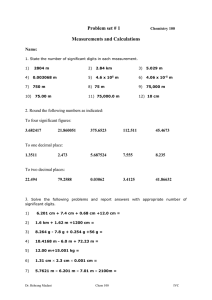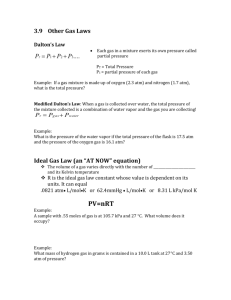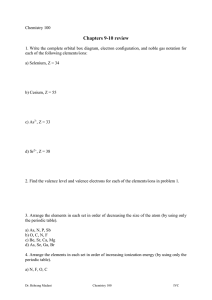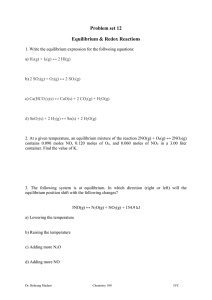Problem set 9 Gases, Liquids, and Solids
advertisement
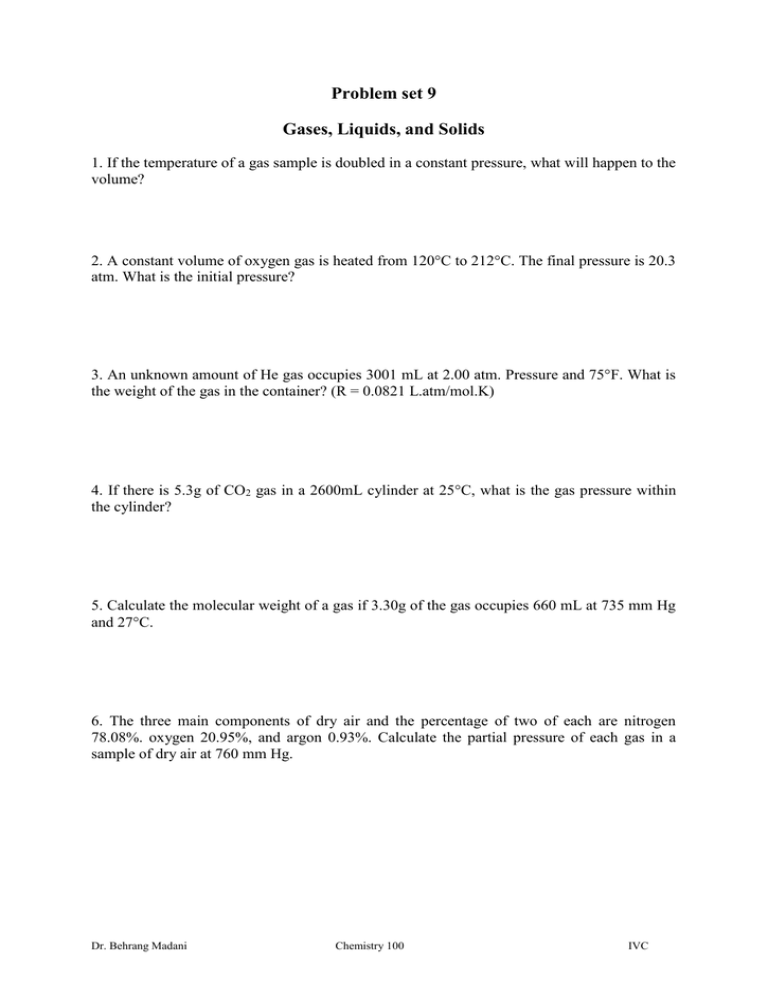
Problem set 9 Gases, Liquids, and Solids 1. If the temperature of a gas sample is doubled in a constant pressure, what will happen to the volume? 2. A constant volume of oxygen gas is heated from 120°C to 212°C. The final pressure is 20.3 atm. What is the initial pressure? 3. An unknown amount of He gas occupies 3001 mL at 2.00 atm. Pressure and 75°F. What is the weight of the gas in the container? (R = 0.0821 L.atm/mol.K) 4. If there is 5.3g of CO2 gas in a 2600mL cylinder at 25C, what is the gas pressure within the cylinder? 5. Calculate the molecular weight of a gas if 3.30g of the gas occupies 660 mL at 735 mm Hg and 27C. 6. The three main components of dry air and the percentage of two of each are nitrogen 78.08%. oxygen 20.95%, and argon 0.93%. Calculate the partial pressure of each gas in a sample of dry air at 760 mm Hg. Dr. Behrang Madani Chemistry 100 IVC 7. We mix 16 L of nitrogen gas at 27C and 1.0 atm with 52 L of neon gas at 27C and 1.0 atm in a 6.0 L tank. Calculate the partial pressure of each gas and total pressure in the tank at 27C. 8. Consider the following reaction: 2H2O2(aq) → 2H2O(g) + O2(g). Suppose 430 mL of oxygen is collected at 32C and has a total pressure of 1.056 atm by this process. What is the partial pressure of oxygen gas in the sample? How many moles of oxygen gas are present in the sample? How many grams of H2O2 must have reacted to produce this quantity of oxygen? (vapor pressure of water is 35.663 mm Hg at 32C). 9. A gaseous mixture contains 12.1 g of N2 and 4.05 g of He. What is the volume of this mixture at STP? 10. Chloroform (CHCl3) can be produced by reaction CH4(g) + 3Cl2(g) → CHCl3(l) + 3HCl(g). In one experiment 25g of CH4 were used. Calculate the volume of HCl produced at 1.0 atm and 27C. 11. Arrange these compounds in each set in order of increasing the boiling point: a) CH3-CH2-CH2-CH2-CH3 CH3-CH2-CH3 CH3-CH2-CH2-CH3 CH3 b) CH3-CH2-CH3 CH3-CH2-CH2-CH2-CH3 CH3-C-CH2-CH3 CH3 Dr. Behrang Madani Chemistry 100 IVC c) Mg(OH)2, CCl4, NH3, CH2Cl2 d) KOH, CO, He, H2O 12. By using the pressure cooker, is the boiling point changed? How? Why? 13. Which substance in each pair has the largest vapor pressure at a given temperature? a) CO or CO2 b) H2O or HCl c) CH4 or CH3OH 14. The molar heat of fusion of sodium metal is 2.60 kJ/mol, whereas its heat of vaporization is 97.0 kJ/mol. What quantity of heat would be needed to melt 1.50 g of sodium at its normal melting point? What quantity of heat would be needed to vaporize 2.6 g of sodium at its normal boiling point? Dr. Behrang Madani Chemistry 100 IVC



